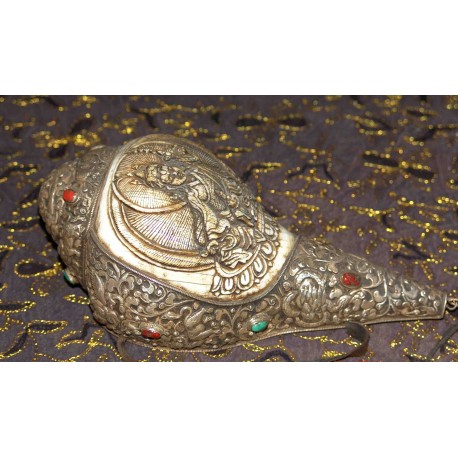No products
- English
- Ελληνικά
 View larger
View larger
- Remove this product from my favorite's list.
- Add this product to my list of favorites.
Ceremonial /decorative Trumpet Conch Shell from Nepal
New product
1 Item
Warning: Last items in stock!
Ceremonial Conch Shell Trumpet 25cm length 11cm wide weight 1.2 kg
CLOCKWISE CONCH.
..a real masterpiece of Handmade work on SILVER ,
The shell has the carved form of "Padmasambhaya" or Guru Rinpoche he who spread Buddhism in Tibet during the 8th century ,togather with coral and turquoise stones.....
The conch shell (Sanskrit shankha; Tibetan dung dkar) has survived as the original horn trumpet since time immemorial. Ancient Indian epics describe how each hero of mythical warfare carried a mighty white conch shell, which often bore a personal name.
Today, in its greatly tamed avatar, the conch is used in Tibetan Buddhism to call together religious assemblies. During the actual practise of rituals, it is used both as a musical instrument and as a container for holy water.Based on its direction of coiling, the shankha has two varieties:
- A Dakshinavarti Shankh: This is the very rare sinistral form of the species, where the shell coils or whorls expand in a counterclockwise spiral if viewed from the apex of the shellThe Dakshinavarta shankha is believed to be the abode of the wealth goddess Lakshmi - the consort of Vishnu, and hence this type of shankha is considered ideal for medicinal use. It is a very rare variety from the Indian Ocean. This type of shankha has three to seven ridges visible on the edge of the aperture and on thecolumella and has a special internal structure. The right spiral of this type reflects the motion of the planets. It is also compared with the hair whorls on the Buddha's head that spiral to the right. The long white curl between Buddha's eyebrows and the conch-like swirl of his navel are also akin to this shankha
- The Vamavarta ("left-turned" as viewed with the aperture uppermost): This is the very commonly occurring dextral form of the species, where the shell coils or whorls expand in a clockwise spiral when viewed from the apex of the shell. In Hinduism, a dakshinavarta shankha symbolizes infinite space and is associated with Vishnu. The Vamavarta shankha represents the reversal of the laws of nature and is linked with Shiva.





